air condition KIA Sportage 2008 JE_ / 2.G Owner's Manual
[x] Cancel search | Manufacturer: KIA, Model Year: 2008, Model line: Sportage, Model: KIA Sportage 2008 JE_ / 2.GPages: 350, PDF Size: 6.42 MB
Page 17 of 350
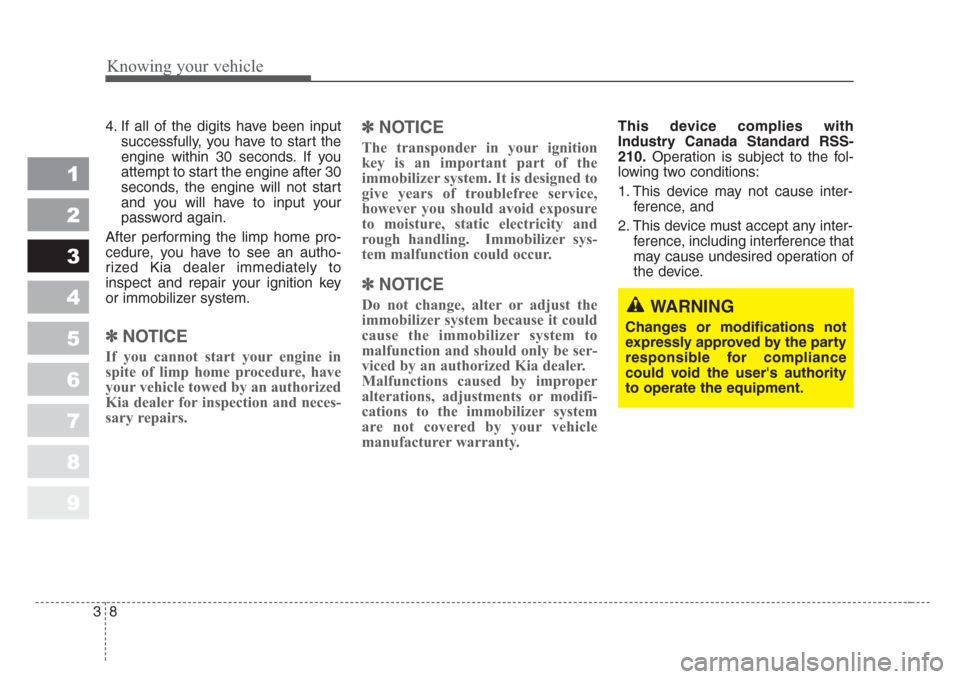
Knowing your vehicle
8 3
1
2
3
4
5
6
7
8
9
4. If all of the digits have been input
successfully, you have to start the
engine within 30 seconds. If you
attempt to start the engine after 30
seconds, the engine will not start
and you will have to input your
password again.
After performing the limp home pro-
cedure, you have to see an autho-
rized Kia dealer immediately to
inspect and repair your ignition key
or immobilizer system.
✽
NOTICE
If you cannot start your engine in
spite of limp home procedure, have
your vehicle towed by an authorized
Kia dealer for inspection and neces-
sary repairs.
✽
NOTICE
The transponder in your ignition
key is an important part of the
immobilizer system. It is designed to
give years of troublefree service,
however you should avoid exposure
to moisture, static electricity and
rough handling. Immobilizer sys-
tem malfunction could occur.
✽
NOTICE
Do not change, alter or adjust the
immobilizer system because it could
cause the immobilizer system to
malfunction and should only be ser-
viced by an authorized Kia dealer.
Malfunctions caused by improper
alterations, adjustments or modifi-
cations to the immobilizer system
are not covered by your vehicle
manufacturer warranty.
This device complies with
Industry Canada Standard RSS-
210.Operation is subject to the fol-
lowing two conditions:
1. This device may not cause inter-
ference, and
2. This device must accept any inter-
ference, including interference that
may cause undesired operation of
the device.
WARNING
Changes or modifications not
expressly approved by the party
responsible for compliance
could void the user's authority
to operate the equipment.
Page 56 of 350
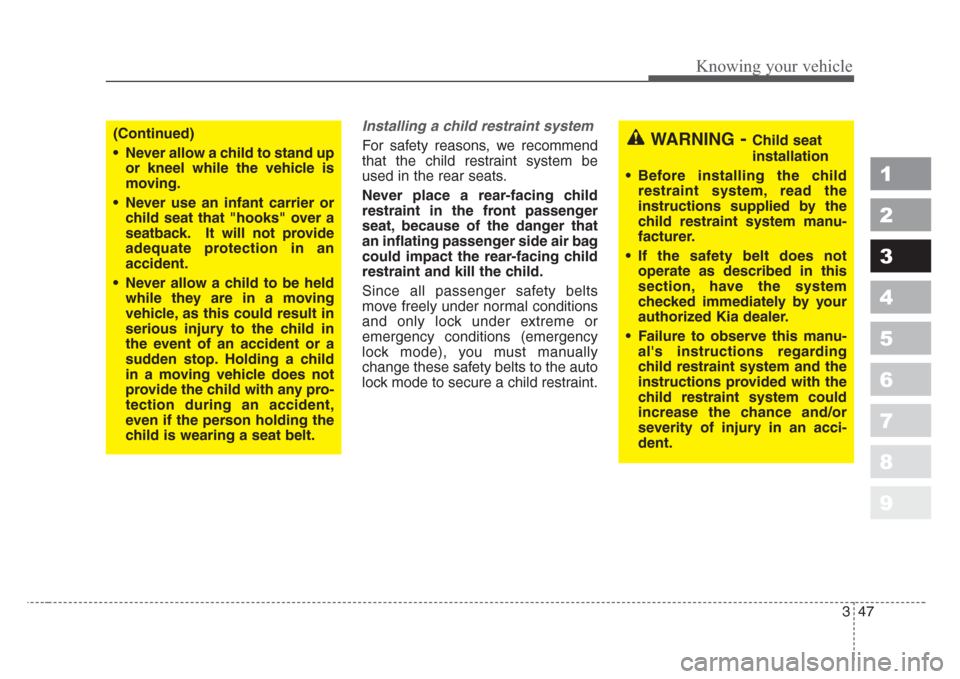
347
Knowing your vehicle
1
2
3
4
5
6
7
8
9
Installing a child restraint system
For safety reasons, we recommend
that the child restraint system be
used in the rear seats.
Never place a rear-facing child
restraint in the front passenger
seat, because of the danger that
an inflating passenger side air bag
could impact the rear-facing child
restraint and kill the child.
Since all passenger safety belts
move freely under normal conditions
and only lock under extreme or
emergency conditions (emergency
lock mode), you must manually
change these safety belts to the auto
lock mode to secure a child restraint.
(Continued)
• Never allow a child to stand up
or kneel while the vehicle is
moving.
• Never use an infant carrier or
child seat that "hooks" over a
seatback.It will not provide
adequate protection in an
accident.
• Never allow a child to be held
while they are in a moving
vehicle, as this could result in
serious injury to the child in
the event of an accident or a
sudden stop.Holding a child
in a moving veh
icle does not
provide the child with any pro-
tection during an accident,
even if the person holding the
child is wearing a seat belt.
WARNING-Child seat
installation
• Before installing the child
restraint system, read the
instructions supplied by the
child restraint system manu-
facturer.
• If the safety belt does not
operate as described in this
section, have the system
checked immediately by your
authorized Kia dealer.
•Failure to observe this manu-
al's ins
tructions regarding
child restraint system and the
instructions provided with the
child restraint system could
increase the chance and/or
severity of injury in an acci-
dent.
Page 64 of 350
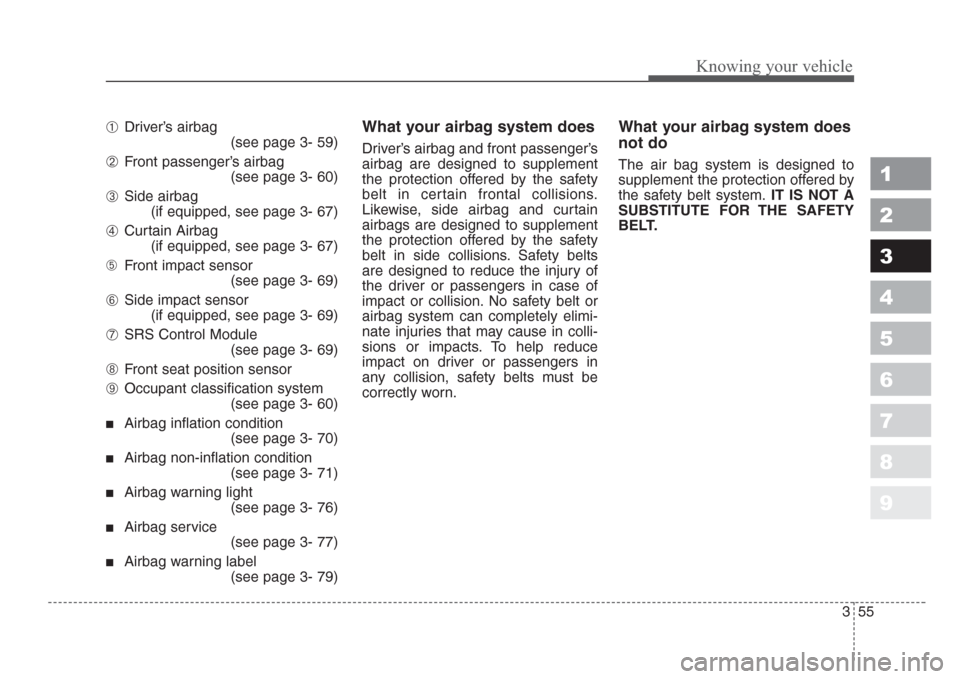
355
1
2
3
4
5
6
7
8
9
Knowing your vehicle
➀Driver’s airbag
(see page 3- 59)
➁Front passenger’s airbag
(see page 3- 60)
➂Side airbag
(if equipped, see page 3- 67)
➃Curtain Airbag
(if equipped, see page 3- 67)
➄Front impact sensor
(see page 3- 69)
➅Side impact sensor
(if equipped, see page 3- 69)
➆SRS Control Module
(see page 3- 69)
➇Front seat position sensor
➈Occupant classification system
(see page 3- 60)
■Airbag inflation condition
(see page 3- 70)
■Airbag non-inflation condition
(see page 3- 71)
■Airbag warning light
(see page 3- 76)
■Airbag service
(see page 3- 77)
■Airbag warning label
(see page 3- 79)
What your airbag system does
Driver’s airbag and front passenger’s
airbag are designed to supplement
the protection offered by the safety
belt in certain frontal collisions.
Likewise, side airbag and curtain
airbags are designed to supplement
the protection offered by the safety
belt in side collisions. Safety belts
are designed to reduce the injury of
the driver or passengers in case of
impact or collision. No safety belt or
airbag system can completely elimi-
nate injuries that may cause in colli-
sions or impacts. To help reduce
impact on driver or passengers in
any collision, safety belts must be
correctly worn.
What your airbag system does
not do
The air bag system is designed to
supplement the protection offered by
the safety belt system.IT IS NOT A
SUBSTITUTE FOR THE SAFETY
BELT.
Page 66 of 350
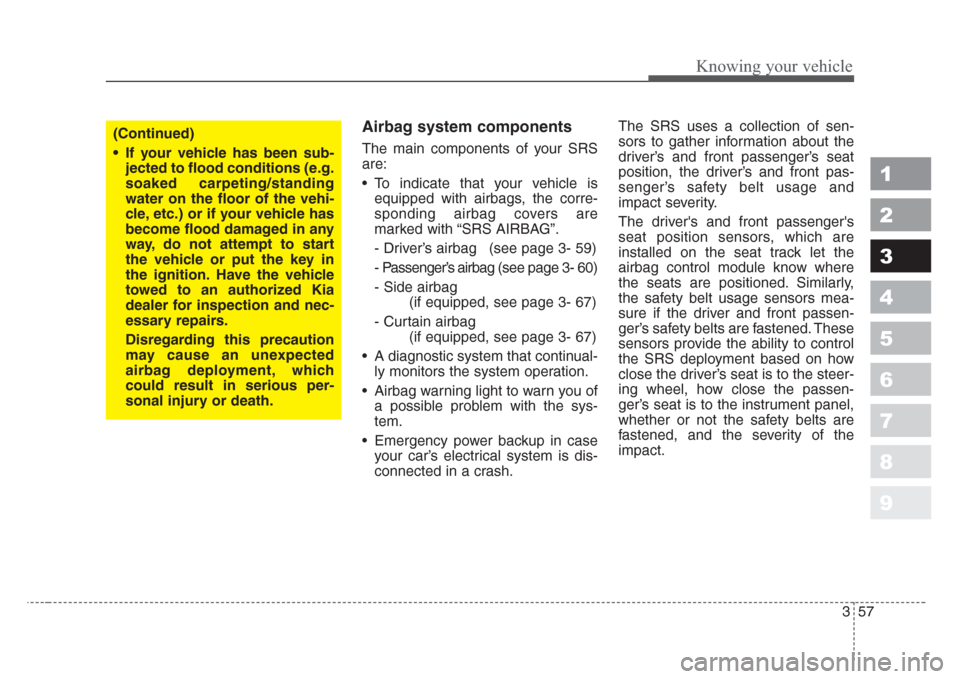
357
1
2
3
4
5
6
7
8
9
Knowing your vehicle
Airbag system components
The main components of your SRS
are:
• To indicate that your vehicle is
equipped with airbags, the corre-
sponding airbag covers are
marked with “SRS AIRBAG”.
- Driver’s airbag (see page 3- 59)
- Passenger’s airbag(see page 3- 60)
- Side airbag
(if equipped, see page 3- 67)
- Curtain airbag
(if equipped, see page 3- 67)
• A diagnostic system that continual-
ly monitors the system operation.
• Airbag warning light to warn you of
a possible problem with the sys-
tem.
• Emergency power backup in case
your car’s electrical system is dis-
connected in a crash.The SRS uses a collection of sen-
sors to gather information about the
driver’s and front passenger’s seat
position, the driver’s and front pas-
senger’s safety belt usage and
impact severity.
The driver's and front passenger's
seat position sensors, which are
installed on the seat track let the
airbag control module know where
the seats are positioned. Similarly,
the safety belt usage sensors mea-
sure if the driver and front passen-
ger’s safety belts are fastened. These
sensors provide the ability to control
the SRS deployment based on how
close the driver’s seat is to the steer-
ing wheel, how close the passen-
ger’s seat is to the instrument panel,
whether or not the safety belts are
fastened, and the severity of the
impact.
(Continued)
• If your vehicle has been sub-
jected to flood conditions (e.g.
soaked carpeting/standing
water on the floor of the vehi-
cle, etc.) or if your vehicle has
become flood damaged in any
way, do not attempt to start
the vehicle or put the key in
the ignition.Have the vehicle
towed to an authorized Kia
dealer for inspection and nec-
essary repairs.
Disregarding this precaution
may cause an unexpected
airbag deployment, which
could result i
n serious per-
sonal injury or death.
Page 67 of 350
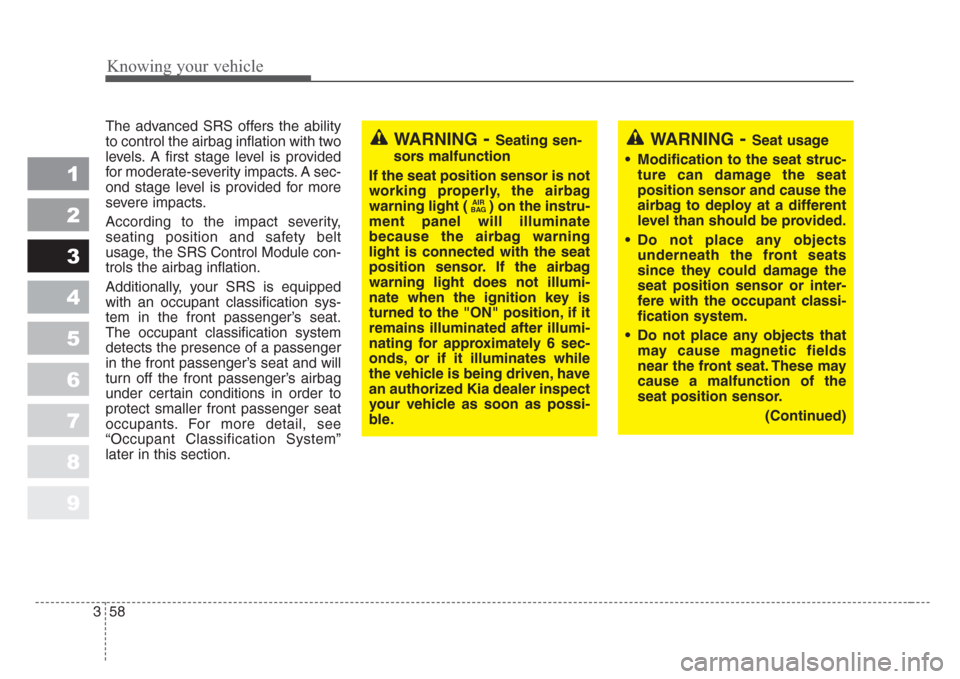
Knowing your vehicle
58 3
1
2
3
4
5
6
7
8
9
The advanced SRS offers the ability
to control the airbag inflation with two
levels. A first stage level is provided
for moderate-severity impacts. A sec-
ond stage level is provided for more
severe impacts.
According to the impact severity,
seating position and safety belt
usage, the SRS Control Module con-
trols the airbag inflation.
Additionally, your SRS is equipped
with an occupant classification sys-
tem in the front passenger’s seat.
The occupant classification system
detects the presence of a passenger
in the front passenger’s seat and will
turn off the front passenger’s airbag
under certain conditions in order to
protect smaller front passenger seat
occupants. For more detail, see
“Occupant Classification System”
later in this section.
WARNING-Seating sen-
sors malfunction
If the seat position sensor is not
working properly, the airbag
warning light ( ) on the instru-
ment panel will illuminate
because the airbag warning
light is connected with the seat
position sensor.If the airbag
warning light does not illumi-
nate when the ignition key is
turned to the "ON" position,if i
t
remains illuminated after illumi-
nating for approximately 6 sec-
onds, or if it illuminates while
the vehicle is being driven, have
an authorized Kia dealer inspect
your vehicle as soon as possi-
ble.
AIR
BAG
WARNING-Seat usage
• Modification to the seat struc-
ture can damage the seat
position sensor and cause the
airbag to deploy at a different
level than should be provided.
• Do not place any objects
underneath the front seats
since they could damage the
seat position sensor or inter-
fere with the occupant classi-
fication system.
• Do not place any objects that
may cause magnetic fields
near the front seat.These may
cause a malfunction of the
seat position sensor.
(Continued)
Page 69 of 350

Knowing your vehicle
60 3
1
2
3
4
5
6
7
8
9
Front passenger’s airbag
Front passenger’s airbag is stored in
the instrument panel on the glove
box.
Never put any objects or ornaments
on the instrument panel.
Occupant classification system
The occupant classification system
detects the presence of a passenger
in the front passenger’s seat and will
turn off the front passenger’s airbag
under certain conditions.
The occupant classification system is
designed to detect the presence of a
properly-seated occupant and deter-
mine if the front passenger’s airbag
should be enabled (may inflate) or
not.If there is no passenger in the front
passenger seat or if the passenger in
the front passenger's seat is very
small (such as a child), the front PAS-
SENGER AIR BAG OFF indicator
may go ON.
When this indicator is ON, the front
passenger's air bag will not deploy.
The side air bag will not deploy if the
front seat is unoccupied.
The side air bag may deploy if the
front seat is occupied by a small
occupant.
1KMB21311KMN3162
1KMA2058
HLZ2121
Page 71 of 350
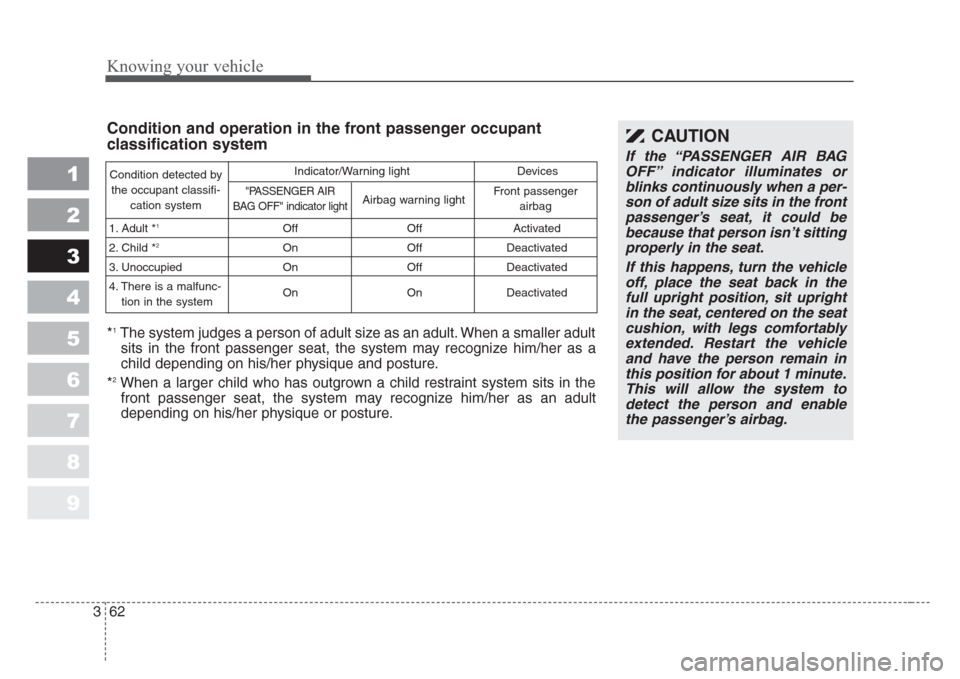
Knowing your vehicle
62 3
1
2
3
4
5
6
7
8
9
CAUTION
If the “PASSENGER AIR BAG
OFF”indicator illuminates or
blinks continuously when a per-
son of adult size sits in the front
passenger’s seat,it could be
because that person isn’t sitting
properly in the seat.
If this happens, turn the vehicle
off, place the seat back in the
full upright position,sit upright
in the seat, centered on the seat
cushion, with legs comfortably
extended.Res
tart the vehicle
and have the person remain in
this position for about 1 minute.
This will allow the system to
detect the person and enable
the passenger’s airbag.
Condition and operation in the front passenger occupant
classification system
Condition detected by
the occupant classifi-
cation system
1. Adult *
1
2. Child *2
3. Unoccupied
4. There is a malfunc-
tion in the system Off
On
On
OnOff
Off
Off
OnActivated
Deactivated
Deactivated
Deactivated
"PASSENGER AIR
BAG OFF" indicator lightAirbag warning lightFront passenger
airbag Indicator/Warning light Devices
*1The system judges a person of adult size as an adult. When a smaller adult
sits in the front passenger seat, the system may recognize him/her as a
child depending on his/her physique and posture.
*
2When a larger child who has outgrown a child restraint system sits in the
front passenger seat, the system may recognize him/her as an adult
depending on his/her physique or posture.
Page 74 of 350
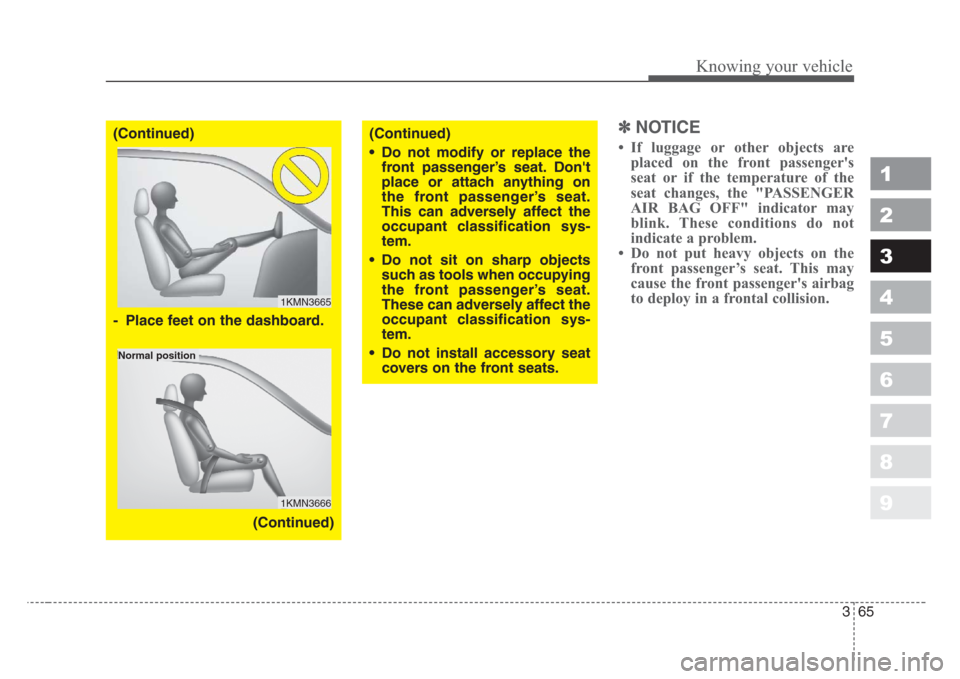
365
1
2
3
4
5
6
7
8
9
Knowing your vehicle
✽
NOTICE
• If luggage or other objects are
placed on the front passenger's
seat or if the temperature of the
seat changes, the "PASSENGER
AIR BAG OFF" indicator may
blink. These conditions do not
indicate a problem.
• Do not put heavy objects on the
front passenger’s seat. This may
cause the front passenger's airbag
to deploy in a frontal collision.
(Continued)
• Do not modify or replace the
front passenger’s seat.Don't
place or attach anything on
the front passenger’s seat.
This can adversely affect the
occupant classification sys-
tem.
• Do not sit on sharp objects
such as tools when occupying
the front passenger’s seat.
These can adversely affect the
occupant classification sys-
tem.
• Do not install accessory seat
covers on the front seats.(Continued)
- Place feet on the dashboard.
(Continued)
1KMN3665
1KMN3666
Normal position
Page 76 of 350
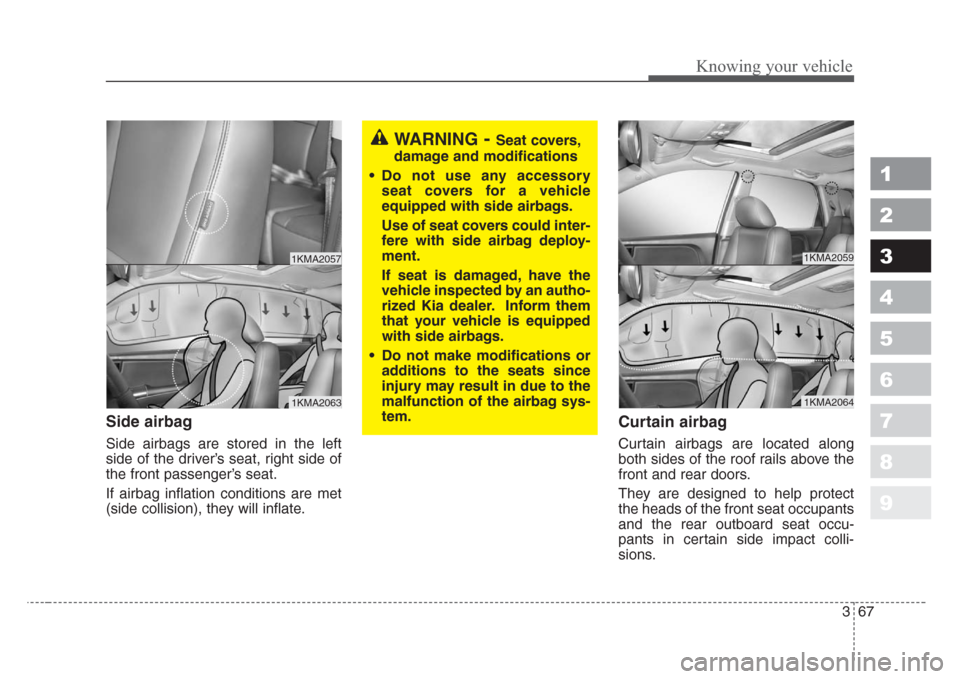
367
1
2
3
4
5
6
7
8
9
Knowing your vehicle
Side airbag
Side airbags are stored in the left
side of the driver’s seat, right side of
the front passenger’s seat.
If airbag inflation conditions are met
(side collision), they will inflate.
Curtain airbag
Curtain airbags are located along
both sides of the roof rails above the
front and rear doors.
They are designed to help protect
the heads of the front seat occupants
and the rear outboard seat occu-
pants in certain side impact colli-
sions.
WARNING-Seat covers,
damage and modifications
• Do not use any accessory
seat covers for a vehicle
equipped with side airbags.
Use of seat covers could inter-
fere with side airbag deploy-
ment.
If seat is damaged, have the
vehicle inspected by an autho-
rized Kia dealer.Inform them
that your vehicle is equipped
with side airbags.
• Do not make modifications or
additions to the s
eats since
injury may result in due to the
malfunction of the airbag sys-
tem.
1KMA2063
1KMA20571KMA2059
1KMA2064
Page 79 of 350
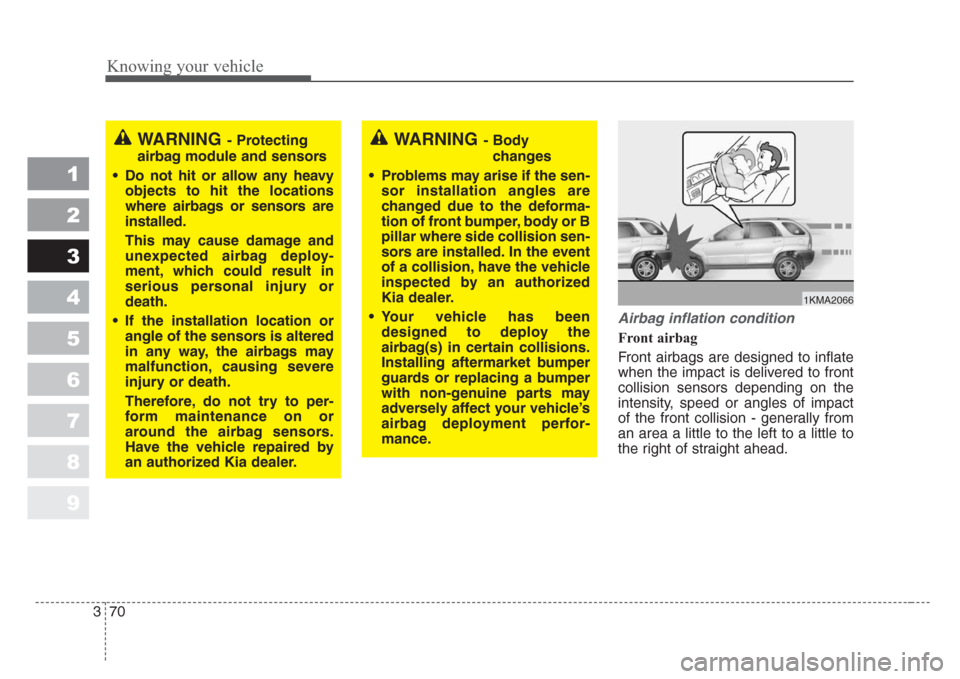
Knowing your vehicle
70 3
1
2
3
4
5
6
7
8
9
Airbag inflation condition
Front airbag
Front airbags are designed to inflate
when the impact is delivered to front
collision sensors depending on the
intensity, speed or angles of impact
of the front collision - generally from
an area a little to the left to a little to
the right of straight ahead.
WARNING- Protecting
airbag module and sensors
• Do not hit or allow any heavy
objects to hit the locations
where airbags or sensors are
installed.
This may cause damage and
unexpected airbag deploy-
ment, which could result in
serious personal injury or
death.
• If the installation location or
angle of the sensors is altered
in any way, the airbags may
malfunction, causing severe
i
njury or death.
Therefore, do not try to per-
form maintenance on or
around the airbag sensors.
Have the vehicle repaired by
an authorized Kia dealer.
WARNING- Body
changes
• Problems may arise if the sen-
sor installation angles are
changed due to the deforma-
tion of front bumper, body or B
pillar where side collision sen-
sors are installed.In the event
of a collision, have the vehicle
inspected by an authorized
Kia dealer.
• Your vehicle has been
designed to deploy the
airbag(s) in certain collisions.
Installing aftermarket bumper
guards or replacing a bumper
with non-genuine parts may
adversely affect your vehicle’
s
airbag deployment perfor-
mance.
1KMA2066